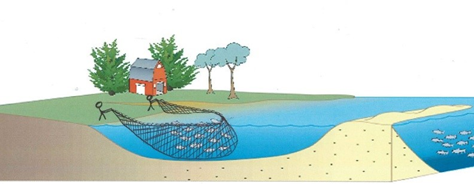Fish salvage
Works within waterways can lead to fish being stranded.
This stranding can cause:
- heat stress
- depleted oxygen levels
- eventual death.
Relocation of fish from areas where stranding may occur, also known as fish salvage, can reduce these risks. Most fish salvage activities require a general fisheries permit. This advice is general. You should always obtain specific advice for large or complex fish salvage operations.
Plan the works
Assess the waterway or potential bund location for ways to minimise fish stress and potential deaths.
Consider site features and conditions:
- site access to safely complete the fish salvage process
- natural contours
- water depth
- the time of year you plan to conduct works.
If possible, the works should be done in the cooler months, when fish are less active and easier to handle.
To make it easier to move fish:
- plan works to reduce the amount of trapped fish
- use temporary pools to keep fish nearer to their habitat during transport
- use a sluicing method to move fish, rather than a container.
Capture fish
Capture fish using nets with a mesh size that minimises injury or death of the fish.
Confirm the nets you propose to use are allowed. Most nets are illegal in non-tidal waters, and a general fisheries permit will generally be required. If you are unsure, contact us.
After removing as many fish as possible:
- lower the water level by 25% and remove as many fish as you can.
- repeat this step every time you reduce the water level by 25% to reduce the risk of overcrowding which can kill fish.

Transfer fish
Prepare the container and water you plan to use.
Your container should:
- be sized for a ratio of 0.2kg of fish per litre of water to maintain safe oxygen and stress levels
- be deep enough to hold enough water to maintain comfortable swimming positions
- have soft, rounded surfaces and a lid
- contain good quality, well oxygenated water.
Where practical, sluicing fish is the preferred method for transferring captured fish, rather than using containers.
The sluice is either:
- a large diameter PVC pipe with smooth joints
- a smooth earthen channel lined with a continuous length of plastic.
A sluice must have an auxiliary flow of water, and:
- a base pool deep enough to cushion the descent of the largest fish
- a receiving pool with a minimum depth of approximately 1 metre
- be sloped no more than a 1:10 ratio.
Maintain water quality
Regularly change or aerate water to maintain safe oxygen levels:
- change 25% to 50% of water hourly, more frequently in hot conditions
- if you use an aerating device, it should bubble oxygen at a rate of 2 to 4 litres per second
- if you use containers, try to keep containers in the shade while working
- if pumps are used to exchange water, make sure the hoses are screened to prevent fish being sucked through and injured
- release fish downstream if suitable conditions exist.
Safely handle fish
Handle fish carefully as you place them in a container or sluice channel:
- support fish of 2kg or more in a horizontal position with 2 hands, or in a knotless net
- observe fish for signs of stress like increased gill movements or swimming at the surface
- monitor water conditions and temperature continuously
- be ready to move, store and release the fish as quickly as possible to reduce handling time.
Reduce the risk of bacterial infections when handling fish:
- use nets with fine, woven, soft, knotless mesh
- handle fish with wet hands, a wet towel, or wet gloves.
Release fish
Check water temperatures carefully before releasing fish.
If the temperatures between the container or temporary pool, and waterway the fish will be released into are:
- equal—you may be able to release fish using a scoop net
- notably different—exchange the water to equalise the temperature before releasing fish.
If you're using the container method, release fish carefully by placing the container in the water and allowing the fish to swim away. Do not allow fish to drop into the water from standing height.
Remove bunds
- Make sure silt fences are in place to prevent erosion.
- Begin removing bunds with the most downstream bund.
- Once bunds are gone, ensure all barrier material is removed from the waterway.
- Check that you have reinstated as much as possible:
- the natural stream channel
- banks of stream to their natural state, contours and vegetation
- the aquatic environment and any fish habitats to their prior condition.
Pest or invasive fish species
Do not return noxious or invasive fish species removed as part of salvage back into the water.
If you find a pest or noxious fish species has been trapped during fish salvage:
- kill the fish immediately and humanely:
- with a quick, sharp blow to the head or;
- by placing the fish in an ice slurry.
- dispose of any bodies far from any waterway or coast, in a bin or buried.
Report pest fish that you have seen and disposed of.
Report fishkill
Report any fishkill events to the pollution hotline at 1300 130 372.